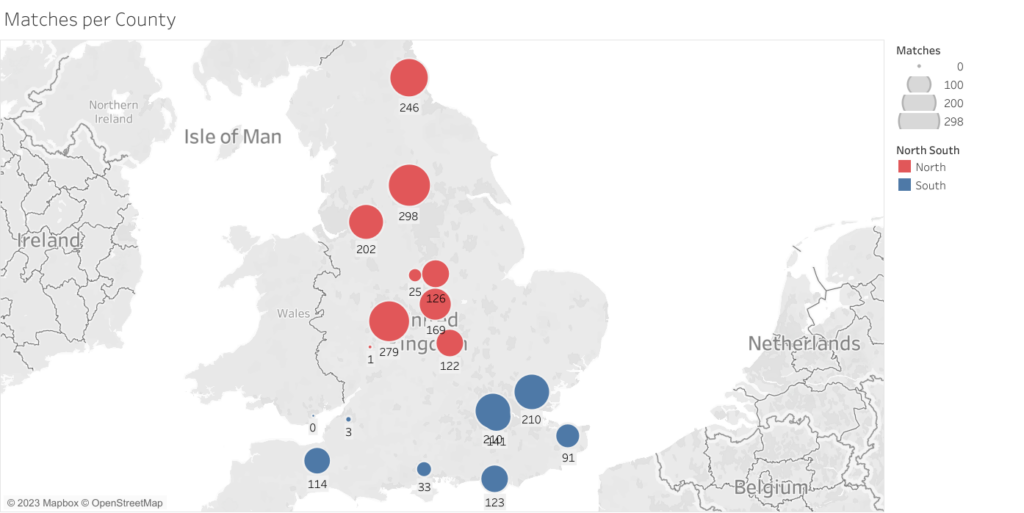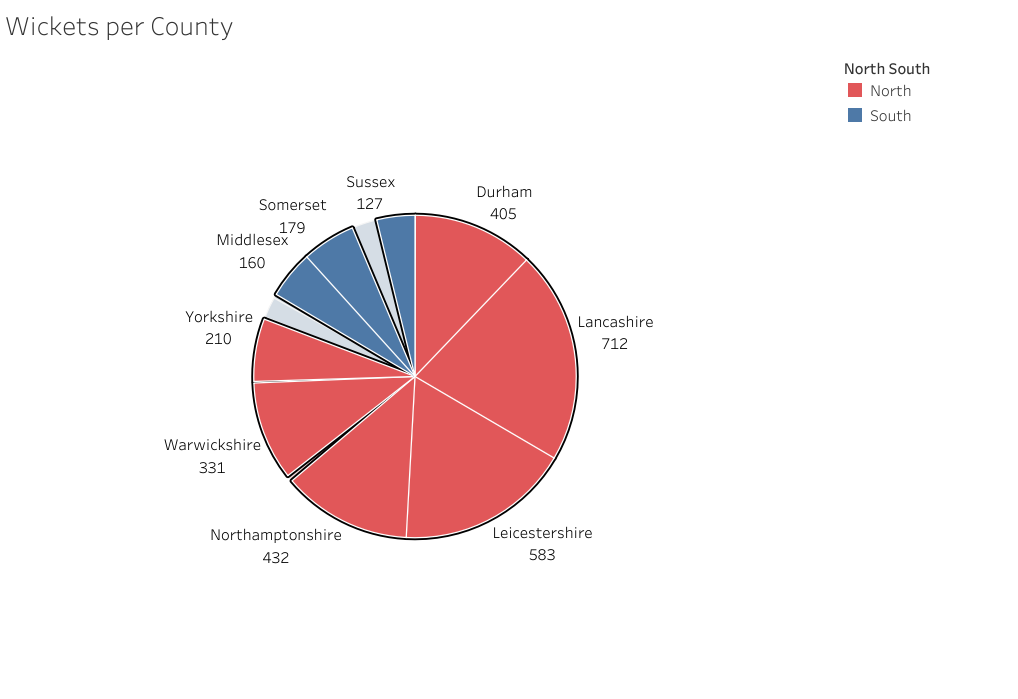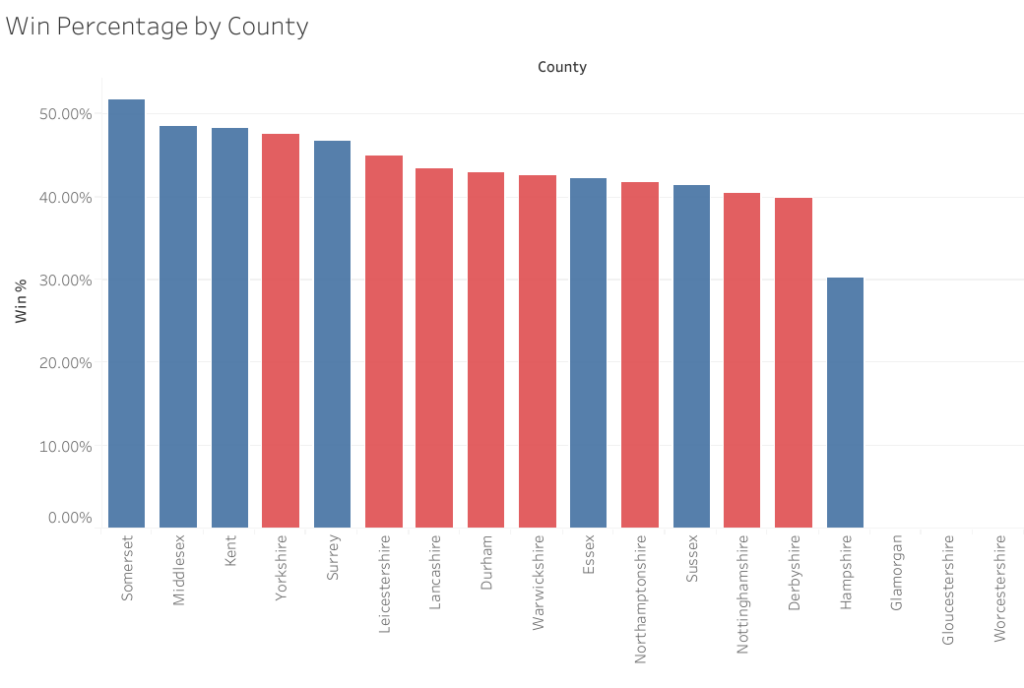Today, Jack Surtees dives deep into the numbers to settle an age-old pub debate. Feel free to express your thoughts in the comments section and suggest any other statistical angles that might be interesting…
It’s the eternal debate. One defined by contentious, subjective, impossible-to-answer issues such as cod vs haddock, ketchup vs gravy and the correct term for the little chunks of batter that fall off a fried fish – ‘batter bits’, ‘scraps’ or something else entirely? Of course, there are cultural differences that exist outside of the local chippie, but to me that is where the great ‘north versus south divide’ becomes most apparent in the UK. Fortunately, today we will be cutting through all the furor, all the accents and various names for sandwiches, to take one small but significant step towards definitively proving who truly are greater: northerners or southerners. Well, with regards to producing English men’s Test cricketers, anyway.
To begin with, there are a few things to address: the first being the confusion that arises when trying to divide Britain into a north and a south. If you were to complete a tour of the pubs found between John O’Groats and Land’s End asking where to place that line of division you would likely find answers ranging from the Tyne to the Thames, and possibly even more extreme. Fortunately, the ECB have already decided which counties they consider northern and which they consider southern, via their T20 Blast groups, so I’ll be using their reckoning for the article.
The next consideration is how to quantify where a player has been ‘produced’. For some, this is simple. Ollie Pope, for example, came through the youth system at Guildford, went on to debut for Surrey and has so far only represented his home county. For others, such as Pope’s one time teammate Kevin Pietersen, it gets a little more complicated. KP was reared in the Kwazulu-Natal province of South Africa where he made his first-class debut, before playing in the Birmingham Premier League and then going on to represent three separate counties in the County Championship. To simplify these more complex situations, I’ve decided to use the club that each player made their County Championship debut at as the county in which they were ‘produced’.
Finally, we come to the period of time to evaluate. I’m looking at this from a modern perspective, so it made sense to look at the careers and the origins of all the players to have made their debuts since the first match of the current squad’s longest serving player – which takes us back an even 20 years, to a world before Bazball, English World Cup triumphs, Mitchell Johnson, and Warne’s 40 wicket series. More specifically, we’ll be looking back to the 22nd of May 2003, when a tearaway young quick with blonde highlights made his debut alongside Anthony McGrath in a team led by Nasser Hussain.
Between the start of that match and the extraordinary 1 run(!) defeat in Wellington, England have handed out 98 caps (including an honorary cap to the Glamorgan wicketkeeper Alan Jones, who played predominantly in the 70s and 80s and has subsequently been omitted from the data). Between them, this group of players have racked up 2,393 Test appearances, scored 111,958 Test runs, taken 3,343 Test wickets, and count amongst their ranks perhaps five players with a claim to be England’s greatest modern Test cricketer. It’s certainly not a group lacking in experience, so let’s see what the numbers tell us.
Players and Matches
During this timespan, Yorkshire and Surrey sit level as the counties with the most debutantes, each providing just enough players to field an XI by themselves. Perhaps surprisingly, seeing as they are the youngest county and have endured a few tough years in recent times, Durham are third in the list with ten players. Only one county hasn’t produced a single debutante since 2003. Glamorgan are seemingly not the club to debut for if you’re a young player harbouring international ambitions.

Overall, in terms of the total number of players to earn caps since 2003, the south slightly pips the north by 52 to 45. That order, however, is reversed if we look at the total number of matches played. The north leading the way with 1299 compared to the south’s 1094.

Clearly these numbers are inflated by the longevity of messrs Anderson, Broad and Root – who, at the time of writing, sit 2nd, 8th and 22nd respectively on the list of most Test appearances (for a combined total of 469 matches!) – but it does suggest that players from the north have been more likely to earn a longer run in the Test set up during the last 20 years. This bears true when we count the number of players with a minimum of 25 Test appearances (around a two-year stint in the Test side given that England are averaging 13 Tests a year since 2003). 13 players from the north meet this criteria combining for a total of 1,077 appearances, whereas only 11 players do so from the south, combining for a total of 762.
In terms of roles, the south have produced more batters (20 to 13), Middlesex leading the way with six. The north just pips the south with regards to bowlers (21 to 20), Lancashire and Durham being the two front runners with five each. The north also leads the way with all-rounders (10 to 5), however, they are comfortably beaten when it comes to wicketkeepers, as Jonny Bairstow is the only player of northern origin to have debuted and kept for England since 2003. The southern counties have seen seven keepers earn caps in that same timespan.
Batting, Bowling and Fielding
There is an old adage that a strong Yorkshire means a strong England, and certainly with regards to run-making this seems to hold true. Just think about the batters that have driven the Bazball machine: Bairstow, Brook and Root are surely the first three that pop to mind, and for good reason too.
During the Stokes-McCullum reign, these three have played 42 innings between them, during which they’ve scored 2,549 runs at a combined average of 71 and a strike-rate of 87. In just 12 Tests and 5 series, they’ve racked up 12 centuries, 8 fifties, 6 Player of the Match awards and 4 Player of the Series awards. Yorkshire truly is the bedrock of the current Test team.
Unsurprisingly then, from our sample, Yorkshire players have provided the England Test team with over 3,000 runs more than any other county, their total nearing the 20,000 mark. Second on the list is Warwickshire (riding on the shoulders of Trott and Bell) and third comes Essex (mainly through the exploits of one Essex based Knight of the Realm). With regards to the north vs south debate, the north is again sitting pretty with 62,491 runs or 54% of all the runs scored by this group of players.


Bowling is a similar story but with an even more pronounced difference. Southern bowlers have taken a combined 1,225 wickets between them, which is only good enough for 37% of the total. The north’s 2,118 wickets are, again, of course boosted by the presence of maybe England’s greatest fast bowling partnership and so it’s no surprise to find Lancashire and Leicestershire (where Broad made his debut) atop the wicket taking lists with 712 and 583 apiece, followed by Northamptonshire, Durham and Warwickshire.
Last, but not least, let’s look at each side’s impact in the field. Here the south leads the way having taken 53% of the catches and 67% of the stumpings with 1,261 and 26 respectively. Credit to Jonny Bairstow again, though, as he’s managed to claim a third of England’s stumpings by himself even though he lost his place as the team’s first choice keeper a few years ago.
Impact on Winning
Finally, we come to the most important figures: those in the win and loss columns. The overall record for our sample players reads 1,064 wins, 525 draws and 804 defeats. Anderson sits atop the pile for most wins (81) and most losses (62), although not the most draws. Despite having played in largely the same era, at the time of writing Cook has played in 39 draws compared to Broad’s 37 and Jimmy’s 36.
Aggregated totals are not really consequential here, though. Those three names sit atop the list courtesy of having played more times for England than anyone else. What is more interesting is a player’s impact on winning – basically, how successful the team has been while each player has been in the XI. There are two figures that we will look at to determine this…
The first is simply their winning percentage (in what percentage of their matches did the team win). The second is slightly more nuanced, however, taking draws into account. I’ve chosen to use the County Championship points system for this (16 points for a win, 8 for a draw) and imagined a scenario where Test matches were played in such a league to then calculate each player’s average points per match.
With a minimum of 25 matches played (to give a reasonable sample size) the player with the highest winning percentage is Jack Leach with 19 wins from 34 matches for a solid 55.88%. Another cult hero left-arm tweaker is the owner of the worst record, however, with Monty Panesar winning only 15 of his 50 matches for a figure of 30%.
When it comes to average County Championship points-per-match we have two different faces at the top and bottom, though. In first place we have the BBC’s newest member of Test Match Special, Steven Finn, with an average of 10.89 points from his 36 matches (20 wins and 9 draws). While rounding off the list is, the rather unfortunate, Rory Burns, who played a large chunk of his Test career through the last stretch of Root’s captaincy when the side infamously had only one win in 17 attempts. His 14 defeats in 32 matches resulted in an average of only 7.5 points per match.

When looking at the figures from a county perspective, we find that the highest winning percentages come from Somerset, Middlesex and Kent with 51.75%, 48.57% and 48.35% respectively. You probably won’t be surprised to find that these counties also occupy the top three slots with regards to points-per-match, although the order is a little jumbled with Middlesex leading the pack at 9.87, followed by Kent (9.58) and Somerset (9.33). Leicestershire are the only other county (and the only northerners) to break the 9 point mark and even so they only just do so with 9.04.

Which brings us to the conclusion of this statistical deep dive…
To sum up, since Anderson made his England Test debut way back in 2003, a budding international prospect has been slightly more likely to earn a cap if they have been the product of a southern county. That being said, it’s the northerners that have been more likely to secure an extended run in the Test side and, as a result, the bulk of England’s Test runs and, especially, their Test wickets have come from northerners. When it comes to winning, however, it seems that the selectors have been justified in their negligible preference for the southern counties since their players just edge the northerners on both winning percentage (45.43% to 43.63%) and point-per-match (9.07 to 8.69).
So what does all this mean for England and the future of their Test team? Hopefully, absolutely nothing. You would hope that any disparity in the availability of opportunities is the result of pure coincidence rather than a systemic focus on one set of counties. Fortunately, the figures are close enough that this seems to be the case.
It is a surprise, though. Being a northerner (at heart) myself, and having spent the last decade plus cheering on the exploits of Stokes, Root, Anderson, and Broad – surely the four greatest English match winners of the era – I started this analysis fully believing that the scales would tip in favour of the northerners. I guess this has played out with regards to the sheer output of an elite group of northerners. But, when viewed through the cold lens of statistics, I must concede that over the past twenty years it’s been southerners, by a whisker, that have provided England with their most likely route to victory.
I don’t reckon I’ll be changing my order from the chippy anytime soon, though. It’ll always be gravy for me.
Jack Surtees









The Yorkshire and Lancashire leagues used to have a solid reputation as the toughest in the country, so it would be logical to assume they produced more talent to pro standard than any others, however this is clearly not the case as neither have dominated since Yorkshire shared the 50’s with Surrey, though it was renowndly harder to get your county cap up north.
Cricketers tend to stay local to their Home Counties so where you’re born and bred can often dictate at least where you begin your professional career. However with the advent of foreign players coming into the county game during the 70’s success could be determined by which top internationals you were able to recruit. Being a Warwickshire man that was self evident in our first championship win in 60 years as West Indieshire with Kallicharran, Kanhai, Gibbs and Murray all making key contributions. This meant that there were fewer places available to local youngsters for a few years, then suddenly you have places to fill with little experience to fill them. Many were tried and failed because they were not instantly successful.
The evidence of slight southern dominance lends weight to the traditional theory that the more remote from HQ you are the less likely you are to be spotted and persevered with, which in turn created a notion of fashionable monied counties who host international games and the rest. In the modern era the Currans are a classic example. Would either have been persevered with if they’d played for Leicester or Derby.
The other thing with cricketers is they tend to take time to mature, often coming to their peak in their 30’s, so if youngsters have intital success and are then dropped after that success petered out they seem to get ignored later in their careers for the next generation of youngsters who have yet to get to know their game. Just because talent isn’t immediately successful doesn’t mean it’s not there. With the modern concentration on white ball it’s easier to make a mark, especially as a batsman, as game time is shorter. Quick 50’s can win games, whereas in red ball the accusation would be why aren’t you converting your 50’s into 100’s, which could well affect your selection at the top level.
I thought the headline was referring to hemispheres….
‘To sum up, since Anderson made his England Test debut way back in 2003, a budding international prospect has been slightly more likely to earn a cap if they have been the product of a southern county.’
This brings to mind the alleged mantra of selectors not so long ago – ‘if in doubt, pick the Middlesex man with the double barrelled name.’
Tongue in cheek this may be, but is does chime with Mark’s observation – the further from HQ…
I wonder if the results would be different if analysed by each Chairman of selectors and/or Captain. My guess is that the May, Dexter and Brearley sides would be more southern orientated and Illingworth’s more northern (Craig White ?!!!). Miller was the first Chairman of selectors with a truly systematic approach. Both he and his fellow selectors watched County cricket almost every day and exchanged views, and also listened to umpires and players. Their final selection was about as free from bias as it is possible to get.
I think that Miller was probably the best we’ve had in recent times. He didn’t crave the spotlight like some Chairmen of Selectors we’ve had. He just got his head down and did the job diligently.
I think a good chairman of selectors has to have a vision. For me Miller didn’t have that, hence his consultation with all and sundry which tended to lead to confused selections based on other people’s opinions. As a player he was a good solid county cricketer but without inspiration. For me David Graveney was better suited for the job with a bit more about him, but that didn’t work out too well either, so perhaps there is no formula for success.
North vs South
Which part of England is worse at BBQs?